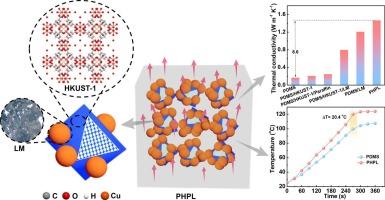科大-1协助液态金属构建聚二甲基硅氧烷基复合材料以改善导热性
IF 6.9
2区 材料科学
Q2 CHEMISTRY, PHYSICAL
引用次数: 0
摘要
由于声子散射引起的界面热阻,多功能高性能聚合物基热界面材料的开发极具挑战性。本文提出了一种简单有效的策略,以HKUST-1为三维骨架构建具有增强导热性的聚二甲基硅氧烷(PDMS)基复合材料(PHPL)。结果表明,PHPL具有优异的热性能,其导热系数为1.47 W m−1 K−1,比PDMS高764.7 %,最大温度变化为20.4 °C。更重要的是,PHPL复合材料的除冰效率显著提高了107.1 %,杨氏模量提高到1.70 MPa。此外,有限元模拟结果表明,导热系数的提高可归因于聚合物内部形成了连续的导热网络,并建立了高导热途径,从而显著降低了界面热阻,促进了有效的传热。这项工作不仅为金属有机框架的应用提供了新的见解,而且为高效热界面复合材料的设计和合成提供了参考。本文章由计算机程序翻译,如有差异,请以英文原文为准。

HKUST-1 assisted liquid metal in constructing polydimethylsiloxane-based composites for improving thermal conductivity
The development of multifunctional and high-performance polymer-based thermal interface materials is extremely challenging due to the interfacial thermal resistance arising from phonon scattering. Herein, a simple and effective strategy is proposed to construct polydimethylsiloxane (PDMS)-based composites (PHPL) with enhanced thermal conductivity using HKUST-1 as a three-dimensional skeleton. The results indicate that PHPL exhibits outstanding thermal performance, with a thermal conductivity of 1.47 W m−1 K−1, which is 764.7 % higher than that of PDMS, and the maximum temperature change achieved was 20.4 °C. More importantly, the deicing efficiency of the PHPL composites was significantly increased by 107.1 %, while Young’s modulus rose to 1.70 MPa. In addition, finite element simulation results revealed that the improvement in thermal conductivity can be attributed to the formation of a continuous thermal conductivity network within the polymer and the establishment of a high thermal conductivity pathway, thereby significantly reducing interfacial thermal resistance and facilitating effective heat transfer. This work not only provides new insights into the application of metal–organic frameworks, but also serves as a reference for the design and synthesis of efficient thermal interface composites.
求助全文
通过发布文献求助,成功后即可免费获取论文全文。
去求助
来源期刊

Applied Surface Science
工程技术-材料科学:膜
CiteScore
12.50
自引率
7.50%
发文量
3393
审稿时长
67 days
期刊介绍:
Applied Surface Science covers topics contributing to a better understanding of surfaces, interfaces, nanostructures and their applications. The journal is concerned with scientific research on the atomic and molecular level of material properties determined with specific surface analytical techniques and/or computational methods, as well as the processing of such structures.
 求助内容:
求助内容: 应助结果提醒方式:
应助结果提醒方式:


